Project Introduction and Objectives
Orpic is one of the largest organizations in the Sultanate of Oman and one of the fastest growing oil and petroleum companies. Partly, its success is explained by its strategic location on the axis of GCC (Gulf Cooperation Council), Asia, and Africa. Political and economic stability including low public debt and low inflation that the Sultanate has been enjoying since the 1970s also contributed to its fast-paced development. For all its success, in 2019, Orpic is facing new challenges one of which is talent management. It is said that many large companies in the Persian Gulf are struggling with attracting, developing, and retaining skilled specialists (Al-Mahrooqi and Denman 2018). Currently, Orpic is working with a limited pull of right caliber Omanis, and those who are successfully hired are often confronted with a lack of a clear career path and growth opportunities.
Foreign language knowledge is a substantial competitive advantage and also something that makes the team stronger and more prepared for international collaboration. Orpic has both domestic and international partners and customers and sends its managers and employees to events and conferences abroad. Unfortunately, not every Omani can boast a good command of English, let alone proficiency required for conducting business operations. In 2018, in the EF English Proficiency Index, Oman ranked 79th out of the total of 88 countries investigated (English First 2018). This result puts the Middle Eastern country in the very low proficiency category. Al-Mahrooqi and Denman (2018) argue that despite considerable investments in education, the government’s efforts to improve the situation have yet to yield any significant gains. Hence,
Orpic cannot expect new employees to come equipped with a decent level of English. It would be best to train them on the spot and in accordance with the company’s goals. Hence, the objective of this project is to assess the employees’ English proficiency and organise business English class es. It is vital to not only concentrate on the employees that contact foreign companies on a regular but also those who are not yet engaged in international trade and collaboration. Foreign language training might empower them, and newly acquired skills might open them to better perspectives within the company. Attending courses together and helping each other grow also contributes to building a friendly corporate environment and strengthens bonds between employees.
Project Team and Their Roles
Organising foreign language training for a company as big as Orpic takes a motivated team that is well aware of their roles and responsibilities. Typically, regardless of the nature of a project, the project team needs to have people who fulfill four essential functions on board (Heizer & Render 2014). The first role is the project sponsor: he or she champions the project and helps other members overcome organisational and institutional obstacles. This person believes in the project, and this genuine engagement pushes him or her to communicate the project’s needs to managers in higher positions. On the project team for corporate language training, the sponsor will be the mediator between the top management and the team.
The second role is the project manager who is responsible for providing a framework for the project’s activities. The project manager identifies and states a problem (subpar English proficiency) and knows what would be the desired outcome (good command of the English language). Thus, he or she outlines the essential steps to reach the goal and determines what resources are needed. On par with the sponsor, the project manager negotiates with authorities. Apart from that, he or she sets milestones and checks on the team leader on team members on a regular basis.
The team leader might be one of the roles that the project manager can take up. However, when it comes to large scale projects for big companies such as Orpic, it is best to have these two roles assigned to two people (Slack et al. 2015). The team leader binds the team together, and he or she is responsible for seeking and retaining talent throughout the project. This person reports back to the project manager, and as opposed to the latter, he or she is more involved in daily routines. As for the present project, the team leader needs to find language teachers and experts to evaluate the overall situation and develop an appropriate educational program.
Project Stages and Key Deliverables
Time Management
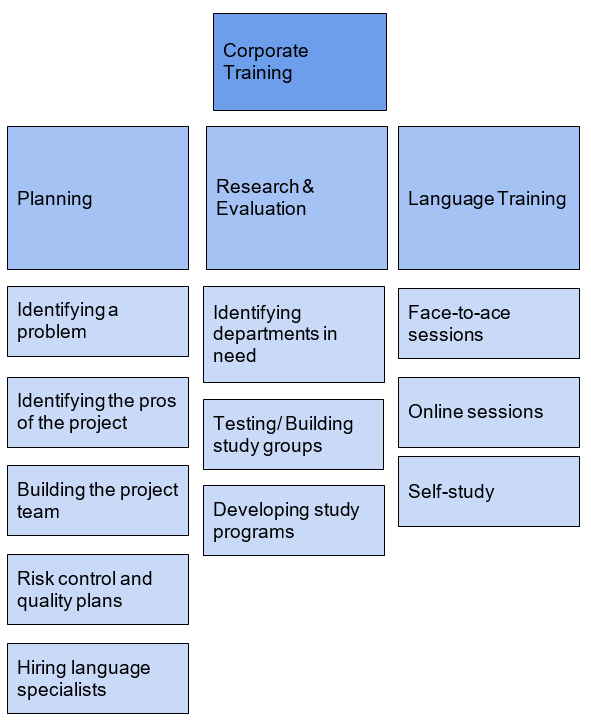
As seen from Scheme 1, the main three stages of the current project include project planning, research & evaluation, and language training per se. Project planning is an essential part of realising any new initiative, especially on a large scale. The project manager and the team leader need to unite their forces and identify steps necessary for reaching the objective. Planning includes budgeting, which can be negotiated through the sponsor, risk assessment, and quality assurance. Talent search, namely, finding skilled language specialists, makes part of the first stage. Orpic needs to focus on enhancing its employees’ communicative skills and business English knowledge and look for candidates who offer appropriate services.
The second stage includes research and evaluation since the solution needs to be well-tailored to consider the current needs of the company. There is not a single right language program; instead, the project manager and the team leader need to find out how well employees know English and what preferences they might have. Language specialists conduct a series of tests (written and spoken) to build study groups according to employees’ real skills. The final stage is the realisation of the project: language training in the forms that meet the company’s needs be it face-to-face training, online courses, or self-study. It is essential that the project team evaluates the amount of time needed for each of the described steps (see Table 1).
Table 1. “Activity List”.
All the listed activities are interconnected, and understanding the steps and sequences is critical to the overall success of the project. While some of the activities can be taking part simultaneously, others require the project team’s undivided attention. Setting priorities straight and acknowledging that the timely realisation of one stage positively impacts the others are what will help the team make progress (Pinto 2016). The order and connections are depicted in Scheme 2 below:
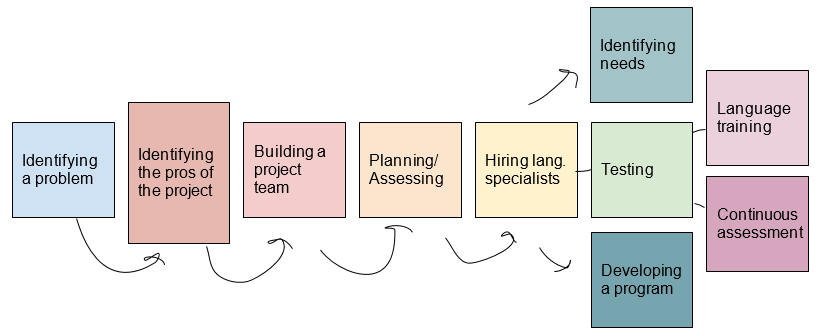
Another useful tool that the project team can employ is the critical path method. Typically, each activity that constitutes a project has two properties: crash duration and float. The former is the smallest amount of time needed to complete a task whereas the latter is how long the team can procrastinate on an assignment to still meet the deadline. It is recommended that the project team makes an effort to reduce the float time to the inevitable minimum; otherwise, the project realisation can drag on for months on end. The critical path does not only visualise the activities but also shows how much time is needed to reach each of the goals and how much money is required in order to complete each step. While budgeting is not the primary topic of the present session, the following critical path illustration will only demonstrate if an activity requires any funding (see Scheme 3).
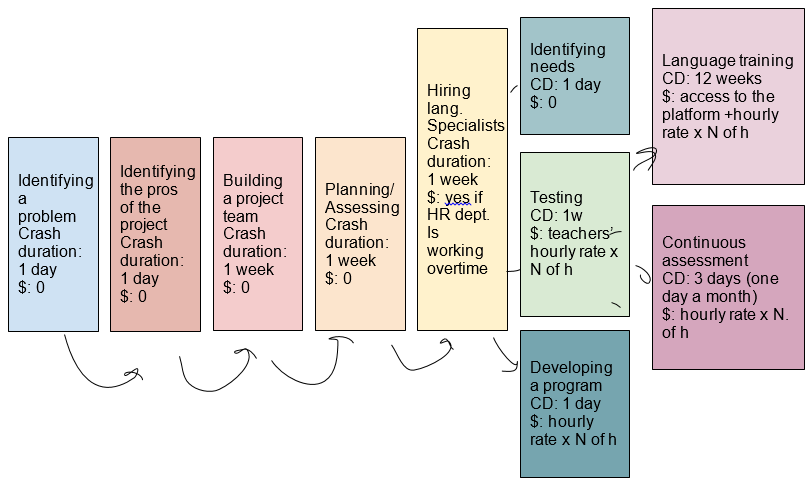
The Gantt chart is probably one of the most widely used tools for project scheduling. So far none of the visual aids demonstrated how task completion could overlap – something not uncommon in the business world. Work Breakdown Structure, Activity List, and Network Diagram might be useful for categorising tasks and showcasing their interconnectivity. However, the Gantt chart shows the nonlinear nature of the project realisation, which might make the whole operation more time-efficient.

Budgeting is probably one of the most challenging parts of project planning. It is not always easy to consider all expenses, but it needs to be done so that the sponsor could negotiate successfully with higher authorities. For the present budget plan, we assumed that the project team detected a department that is in dire need of improving their language skills. The number of employees enrolled is 100, and the number of groups is ten. Classes take place three times a week and last 1,5 hour. It is planned that if the first groups show good results, more training sessions will be organised to involve a more significant number of people. It is also assumed that the project team did the planning during their office hours and did not need to be paid for overworking.

Quality Plan
Table 4. “Quality Assessment”.
Quality assessment is essential for making sure that a project progresses as expected and passes the set milestones. In the case of Orpic, it is planned that quality assessment will be conducted at the end of each of the three stages: planning, research & evaluation, and language training. One of the end product of project planning (Stage 1) is a team specialists in the field of linguistics and education. Their skills should be tested by using both formal and informal means. First, the team leader should arrange a performance test and make sure that their command of English corresponds that stated in their legal documents. The test can take place online; however, supervision is crucial to eliminate the possibility of cheating. Interviewing might be a good informal tool to understand candidates’ values and work ethics. Teaching requires constant human interaction, and an interview is a way to showcase soft skills such as communication, negotiation, and conflict resolution.
The second quality assessment is the employees’ evaluation that is of great importance for choosing an appropriate language study program and adjusting it further to meet their needs. The tests should be organised by the teachers with the help from the project team who needs to provide them with rooms and equipment such as computers. The end product of this type of assessment is test results that will help to create a fuller picture of the employees’ strengths and growth zones. Lastly, the third assessment is conducted through a series of language tests and questionnaires. Each month, together with the teachers, the project team tracks the progress that the attendants are making. Formal testing shows how well they process and retain new information while questionnaires show their motivation and engagement. Conducting a survey might also help to gather feedback and make adjustments to the curriculum.
Risk Log/ Register
Risk assessment is a crucial part of each project plan. The present project is to be realised on a large scale, at least in the context of the given organisation, and a single mistake can cost a lot. The first is related to the involvement of the third party: while Orpic managers are familiar with their employees and their skills, assessing external sources of talent can be reasonably challenging. When looking for foreign language teachers, Orpic hopes for a long and fruitful collaboration. Making changes to the teaching staff is something the company would like to avoid at any cost, which is why hiring should be conducted with the utmost care.
The second risk is the employees’ lack of motivation and poor attendance. Learning English can prove to be challenging for some of the attendants, and initial failures might deter them from putting more effort into acquiring a new skill. It is critical that in this case, the managers do not scold the attendants for their lack of engagement. Instead of punishing them, the project team should come up with a reward system so that improving English would be more attractive for the employees (Maylor 2010). First, the project team could outline career growth opportunities for those who develop their language skills enough to be eligible for a certificate. Second, there might be some compensation for their effort in the form of event tickets and other treats.
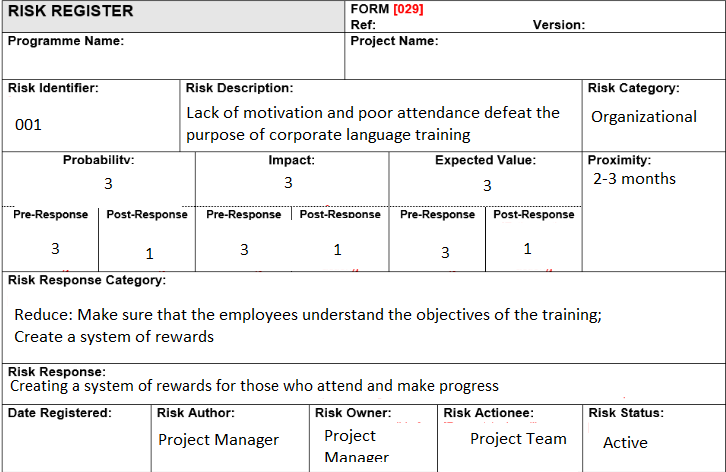
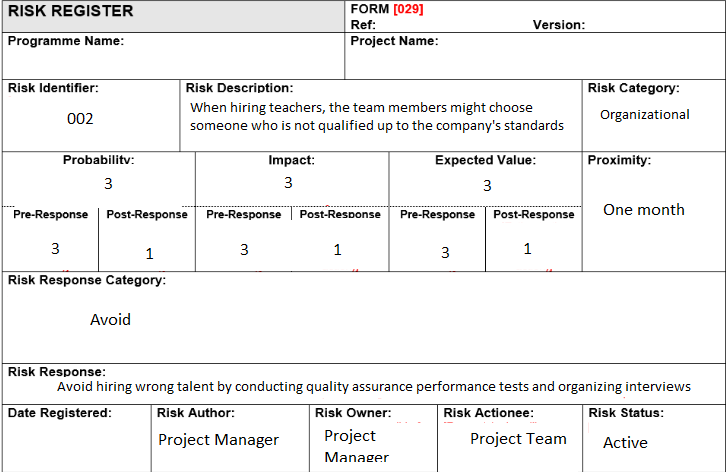
Reference List
Al-Mahrooqi, R & Denman, C 2018, English education in Oman: current scenarios and future trajectories, Springer, New York.
English First, 2018, EF EPI Oman, Web.
Heizer, J, & Render, B 2014, Operations management: sustainability and supply chain management, 11th global edn, Pearson Prentice Hall, London.
Maylor, H 2010, Project management, 4th edn, Prentice Hall, London.
Pinto, JK 2016, Project management: achieving competitive advantage, 4th edn, London.
Slack, N, Brandon-Jones, A, Johnston, R, & Betts, A 2015, Operations and process management: principles and practice for strategic impact, 4th edn, London.